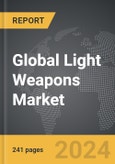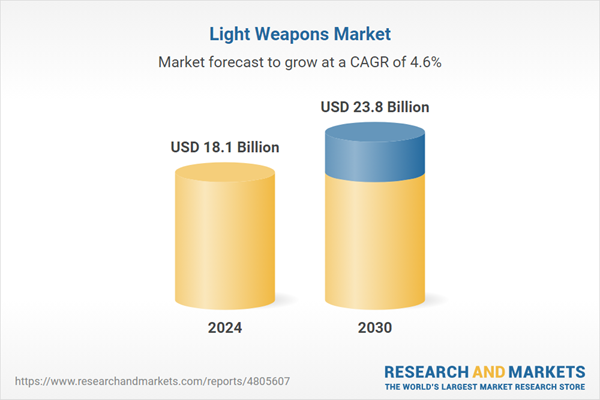The global market for Light Weapons was valued at US$18.1 Billion in 2024 and is projected to reach US$23.8 Billion by 2030, growing at a CAGR of 4.6% from 2024 to 2030. This comprehensive report provides an in-depth analysis of market trends, drivers, and forecasts, helping you make informed business decisions. The report includes the most recent global tariff developments and how they impact the Light Weapons market.
Segments: Guidance Type (Unguided, Guided); Application (Defense, Homeland Security).
Geographic Regions/Countries: World; United States; Canada; Japan; China; Europe (France; Germany; Italy; United Kingdom; and Rest of Europe); Asia-Pacific; Rest of World.
The analysts continuously track trade developments worldwide, drawing insights from leading global economists and over 200 industry and policy institutions, including think tanks, trade organizations, and national economic advisory bodies. This intelligence is integrated into forecasting models to provide timely, data-driven analysis of emerging risks and opportunities.
Global Light Weapons Market - Key Trends & Drivers Summarized
Why Are Light Weapons Critical in Modern Warfare?
Light weapons, including small arms and man-portable weapons such as rocket launchers and anti-tank missiles, play a crucial role in modern warfare and defense strategies. These weapons are designed for ease of transport and operation, making them essential for infantry units, special forces, and irregular combat scenarios. Light weapons are highly effective in both conventional and asymmetric warfare, providing military forces with the flexibility to engage in a wide range of combat situations. The demand for light weapons is driven by ongoing geopolitical tensions, the need for military modernization, and the rise of unconventional warfare tactics. As global security challenges evolve, the importance of light weapons in equipping armed forces with the tools necessary for rapid deployment and effective combat continues to grow.How Are Technological Advancements Shaping the Light Weapons Market?
Technological advancements are significantly enhancing the capabilities of light weapons, making them more accurate, lethal, and adaptable to various combat scenarios. Innovations in materials science have led to the development of lighter and more durable weapons, improving mobility and reducing the physical burden on soldiers. Advances in optics and targeting systems, including the integration of night vision and thermal imaging, are increasing the effectiveness of light weapons in low-visibility conditions. Additionally, the development of smart munitions and guided projectiles is enhancing the precision of light weapons, reducing collateral damage and increasing their utility in urban and complex environments. The integration of digital technologies, such as GPS and data links, is also enabling real-time communication and coordination among units, further improving the effectiveness of light weapons on the battlefield.What Are the Key Military and Defense Trends Driving the Light Weapons Market?
The light weapons market is heavily influenced by military and defense trends, particularly the growing emphasis on mobility, versatility, and asymmetric warfare. As military forces around the world prioritize rapid deployment and the ability to operate in diverse environments, the demand for portable and adaptable light weapons is increasing. The rise of asymmetric warfare, where state and non-state actors engage in irregular combat, is driving the need for weapons that can be easily transported and operated by small units or individuals. Additionally, the trend towards modernization and the replacement of aging military equipment is leading to increased procurement of advanced light weapons by defense forces globally. The focus on counterterrorism and the need to equip special operations forces with highly effective tools are also significant drivers of the light weapons market.What Is Driving the Growth in the Light Weapons Market?
The growth in the light weapons market is driven by several factors. The ongoing modernization of military forces, particularly in developing countries, is a significant driver, as governments seek to equip their armed forces with the latest weapons technology. Technological advancements in weapon design, materials, and targeting systems are making light weapons more effective and desirable for military operations, contributing to market growth. The increasing prevalence of asymmetric warfare and the need for rapid deployment capabilities are also driving demand for light weapons that can be easily transported and operated in various combat scenarios. Additionally, geopolitical tensions and the rise of non-state actors are creating new opportunities for light weapons manufacturers, as countries and defense organizations seek to enhance their military readiness and response capabilities. The expansion of global defense budgets and the increasing focus on counterterrorism efforts are further propelling the market, as light weapons remain a critical component of modern military arsenal.Report Scope
The report analyzes the Light Weapons market, presented in terms of units. The analysis covers the key segments and geographic regions outlined below.Segments: Guidance Type (Unguided, Guided); Application (Defense, Homeland Security).
Geographic Regions/Countries: World; United States; Canada; Japan; China; Europe (France; Germany; Italy; United Kingdom; and Rest of Europe); Asia-Pacific; Rest of World.
Key Insights:
- Market Growth: Understand the significant growth trajectory of the Unguided segment, which is expected to reach US$13.5 Billion by 2030 with a CAGR of a 4.1%. The Guided segment is also set to grow at 5.3% CAGR over the analysis period.
- Regional Analysis: Gain insights into the U.S. market, valued at $4.9 Billion in 2024, and China, forecasted to grow at an impressive 4.4% CAGR to reach $3.7 Billion by 2030. Discover growth trends in other key regions, including Japan, Canada, Germany, and the Asia-Pacific.
Why You Should Buy This Report:
- Detailed Market Analysis: Access a thorough analysis of the Global Light Weapons Market, covering all major geographic regions and market segments.
- Competitive Insights: Get an overview of the competitive landscape, including the market presence of major players across different geographies.
- Future Trends and Drivers: Understand the key trends and drivers shaping the future of the Global Light Weapons Market.
- Actionable Insights: Benefit from actionable insights that can help you identify new revenue opportunities and make strategic business decisions.
Key Questions Answered:
- How is the Global Light Weapons Market expected to evolve by 2030?
- What are the main drivers and restraints affecting the market?
- Which market segments will grow the most over the forecast period?
- How will market shares for different regions and segments change by 2030?
- Who are the leading players in the market, and what are their prospects?
Report Features:
- Comprehensive Market Data: Independent analysis of annual sales and market forecasts in US$ Million from 2024 to 2030.
- In-Depth Regional Analysis: Detailed insights into key markets, including the U.S., China, Japan, Canada, Europe, Asia-Pacific, Latin America, Middle East, and Africa.
- Company Profiles: Coverage of players such as BAE Systems PLC, Cockerill Maintenance & Ingenierie (CMI), Fn Herstal S.A., General Dynamics Corporation, Heckler & Koch Defense, Inc. and more.
- Complimentary Updates: Receive free report updates for one year to keep you informed of the latest market developments.
Some of the 36 companies featured in this Light Weapons market report include:
- BAE Systems PLC
- Cockerill Maintenance & Ingenierie (CMI)
- Fn Herstal S.A.
- General Dynamics Corporation
- Heckler & Koch Defense, Inc.
- Lockheed Martin Corporation
- Northrop Grumman Corporation
- Raytheon Company
- Rheinmetall AG
- SAAB AB
- Thales Group
Tariff Impact Analysis: Key Insights for 2025
Global tariff negotiations across 180+ countries are reshaping supply chains, costs, and competitiveness. This report reflects the latest developments as of April 2025 and incorporates forward-looking insights into the market outlook.The analysts continuously track trade developments worldwide, drawing insights from leading global economists and over 200 industry and policy institutions, including think tanks, trade organizations, and national economic advisory bodies. This intelligence is integrated into forecasting models to provide timely, data-driven analysis of emerging risks and opportunities.
What’s Included in This Edition:
- Tariff-adjusted market forecasts by region and segment
- Analysis of cost and supply chain implications by sourcing and trade exposure
- Strategic insights into geographic shifts
Buyers receive a free July 2025 update with:
- Finalized tariff impacts and new trade agreement effects
- Updated projections reflecting global sourcing and cost shifts
- Expanded country-specific coverage across the industry
Table of Contents
I. METHODOLOGYII. EXECUTIVE SUMMARY2. FOCUS ON SELECT PLAYERS3. MARKET TRENDS & DRIVERSIII. MARKET ANALYSISIV. COMPETITION
1. MARKET OVERVIEW
4. GLOBAL MARKET PERSPECTIVE
UNITED STATES
CANADA
JAPAN
CHINA
EUROPE
FRANCE
GERMANY
ITALY
UNITED KINGDOM
REST OF EUROPE
ASIA-PACIFIC
REST OF WORLD
Companies Mentioned (Partial List)
A selection of companies mentioned in this report includes, but is not limited to:
- BAE Systems PLC
- Cockerill Maintenance & Ingenierie (CMI)
- Fn Herstal S.A.
- General Dynamics Corporation
- Heckler & Koch Defense, Inc.
- Lockheed Martin Corporation
- Northrop Grumman Corporation
- Raytheon Company
- Rheinmetall AG
- SAAB AB
- Thales Group
Table Information
| Report Attribute | Details |
|---|---|
| No. of Pages | 241 |
| Published | April 2025 |
| Forecast Period | 2024 - 2030 |
| Estimated Market Value ( USD | $ 18.1 Billion |
| Forecasted Market Value ( USD | $ 23.8 Billion |
| Compound Annual Growth Rate | 4.6% |
| Regions Covered | Global |









